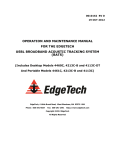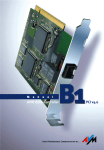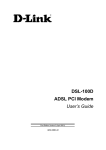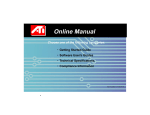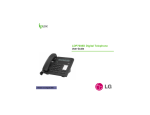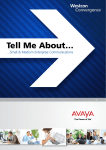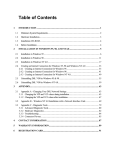Download BT Speedway ISDN Installation guide
Transcript
Speedway ISDN PCI card Internal ISDN PCI card for PCs Installation Guide Contents 1. Welcome to the Speedway! 2 2. Before you start 3 2.1 Check the Contents 3 2.2 PC System Requirements 3 2.3 About the Speedway! CD 4 3. Installation 5 3.1 Determine what version of Windows you are using 5 3.2 Installing the Speedway ISDN PCI Card 6 3.3 Device Driver Installation 7 3.4 Installing the Speedway! Applications & the CAPI Port Driver 13 3.5 Setting up Internet access 15 3.6 Uninstalling the Speedway PCI Card and Applications 18 4. Typical use examples 19 5. Troubleshooting and Support 21 6. Technical Information 25 6.1 CAPI Port Drivers 25 6.2 Internet Access 26 6.3 ISDN Information 27 6.4 Product Specifications 29 7. Software Licence Agreement 30 8. Index 32 1 1.Welcome to the Speedway! The Speedway ISDN PCI Card is an internal PC card which enables fast data communications to and from your PC via ISDN or BT Highway service. You will be able to browse the Internet and download files, images and programs at speeds unavailable via modems connected to the analogue network. You can also access other remote sites that have both access to the ISDN and compatible terminal equipment. Your Speedway ISDN PCI Card can combine both ISDN channels to provide a data speed of up to 128Kbps. WELCOME Note The actual data speed obtained is dependent upon the data speed offered by your Internet service provider or that of the remote site you connect to. You can install the supplied software under Windows 95, 98 and NT. For further information, please refer to the relevant installation sections. Also included is a suite of applications that form an integrated communications package. These programs enable you to make the best use of your Speedway ISDN PCI Card: Speedway! data allows you to transfer data at high speed to and from other PC users who have access to the ISDN and have a compatible terminal adapter and software. Speedway! fax allows transmission of faxes very quickly and directly from a word processing program. Speedway! phone is a virtual ISDN desktop telephone, providing ISDN voice communication via your PC’s soundcard. Speedway! answer gives you an ISDN answering machine on your PC if you have a sound card installed. Speedway! term allows you to quickly load information from an ISDN Bulletin Board Service. See ‘Typical use examples’ on page 18 for more information on the use of these applications. 2 2. Before you Start... Please take a few minutes to read this guide and acquaint yourself with both the installation process and the features of your card. Installation is simple but you must take care to follow the instructions carefully in order to get the best from your Speedway ISDN PCI Card. Note BEFORE YOU START This guide assumes that you have a basic understanding of PCs and MS Windows. If you are new to PCs, please make sure that you read and understand any documentation that was delivered with your machine. If you are new to MS Windows, make sure you try the various Windows tutorials before attempting any installations. 2.1 Check the Contents After opening and unpacking the box, you will find the following items: • • • • Speedway ISDN PCI Card ISDN cable (6m) Speedway! CD-ROM Installation Guide (this document) 2.2 PC System Requirements Before attempting installation, please check that your PC meets the following requirements: • • • • • A Pentium processor with a recommended minimum 16Mb RAM A Microsoft Windows 95, 98 or NT (Workstation i386) operating system 10Mb hard disc space A CD-ROM drive A free PCI plug-in slot If you are unsure of your PC’s specification or compatibility, please refer to your PC manual or equipment supplier. 3 Note If your PC is already equipped with an ISDN adapter, you must first un-install it and its drivers before you can successfully install the Speedway ISDN PCI Card and its software. The un-installation process of ISDN adapters may vary depending on the manufacturer. Please follow the manufacturer’s guidelines for removal. 2.3 About the Speedway! CD BEFORE YOU START The CD includes an introduction which provides you with information about its contents and assists you with the installation of your card in Windows 95, 98 or NT. The introduction should start automatically when you insert the CD into your computer. If not, you can start the introduction manually by going into Explorer (or using Start - Run menu) and then double-clicking on the intro.hlp file in the root directory of the CD. The CD contains the Speedway ISDN PCI card installation program for Windows 95, 98 and NT. It also contains the installation program for the Speedway! applications as well as additional software that may be useful. Note Some of the documents on the CD are .pdf (Portable Document Format) files. You can read, search and print these documents by using the Adobe Acrobat Reader. If your PC has not been loaded with Adobe Acrobat you will find an installable copy on the CD. Software updates are available via the Speedway website: www.speedway.bt.com 4 3.Installation Installation consists of five stages: 3.1 Determine what version of Windows you are using. 3.2 Physical installation of your card into to your PC and ISDN socket connection. 3.3 Device driver installation. 3.4 Speedway! applications and CAPI port driver installation. 3.5 Internet access set-up Important INSTALLATION It is important to follow the sequence of installation steps as specified. If you fail to follow these instructions you may not be able to successfully install your card. You will not be able to access the Internet until you have completed stages 3.1 to 3.5 above! It is a good idea to view the Readme files on the CD before installing your card for the latest product information and installation advice. 3.1 Determine what version of Windows you are using If you are using Windows 98 or Windows NT, you will be aware of this from the Windows start-up screen. If you are using Windows 95 it is essential that you determine what version you are using before you physically install your PCI card. 1. Double-click the My Computer icon on the Desktop, double-click the Control Panel icon and then double-click the System icon. 2. Under the tab General will be a description of what version of Windows is installed. For example: Microsoft Windows 95 4.00.950 B Make a note of this for use in Section 3.3. 5 3.2 Installing the Speedway ISDN PCI Card 1. Switch off your PC and unplug the power connector cable. 2. Remove the cover from your PC. 3. Select an appropriate slot (Figure 1) and with a suitable screwdriver, carefully remove the screw from the adjacent protective plate from the rear of the PC. Do not allow this screw to drop into the computer. INSTALLATION Figure 1 indicates a typical PC board showing how your card connectors may be arranged. Note that the PCI card should be installed in one of the smaller sockets. Figure 1 4. Gently insert the card into the slot with the back plate facing the rear of the PC. Press down until the card is fully located into the slot. Do not disturb the PC’s internal wiring during installation. 5. Replace the retaining screw in order to secure the card back-plate to the rear of the PC. 6. Replace the cover of your PC, tighten any retaining screws and reconnect the power connector cable. Warning If you are in any doubt about how to access the inside of your PC, you should contact your PC supplier for advice. ISDN Connection 1. Take the ISDN cable supplied and insert the plug on one end of the ISDN cable into the socket on the rear plate of the Speedway ISDN PCI Card. 6 2. Insert the other end of the ISDN cable into your ISDN or BT Highway socket. 3. Switch PC on. The physical installation of your Speedway ISDN PCI Card is now complete. 3.3 Device Driver Installation Depending on which version of Windows you determined earlier: If you have: Complete Section 3.3, Part A & Part E. Windows 95 version B: Complete Section 3.3, Part B & Part E. Windows 98: Complete Section 3.3, Part C & Part E. Windows NT: Complete Section 3.3, Part D & Part E. INSTALLATION Windows 95 version A: A For Windows 95 Version 4.00.950 or 4.00.950a 1. Switch on your PC, if you have not already done so, and Windows will automatically detect the card you have just installed. 2. The ‘New Hardware Found’ screen will be displayed, announcing that it has recognised the BT Speedway PCI card as a ‘PCI Network Controller’. If this screen is not displayed, close down Windows, switch off your PC and check that the card is physically installed correctly. 3. Select ‘Driver from the disk provided by hardware manufacturer’, click OK. 4. Your PC will display a prompt asking you to insert the manufacturer’s installation disk. Place the BT Speedway PCI Card CD in your PC’s CD drive. 5. Click Browse, in the ‘Drives’ section and select your CD ROM drive letter. Double-click on Cardware which will be shown in the ‘Folders’ section and double-click on Windows.95. Click OK and click OK again on the following screen. 6. After the files are copied to your PC, the ‘BT Speedway ISDN PCI Card’ screen will be shown (Figure 2). 7 Figure 2 7. Now follow the instructions in Part E. B For Windows 95 Version 4.00.950b INSTALLATION 1. Switch on your PC, if you have not already done so, and Windows will automatically detect the card you have just installed. 2. The ‘New Hardware Found’ screen will be displayed. If this screen is not displayed, close down Windows, switch off your PC and check that the card is physically installed correctly. 3. Immediately after the ‘New Hardware Found’ screen is displayed the ‘Update Device Driver’ wizard will be started and it’s initial display shown. 4. Insert the BT Speedway PCI Card CD in your PC’s CD drive. 5. Click Next and wait whilst Windows updates it’s driver database. This will take a few seconds. 6. Windows will announce that it cannot locate the driver for the recognised device. Click Other Locations, and you will be prompted to enter a ‘Path’ name. 7. Either type D:\CARDWARE\WINDOWS.95 (where D should be substituted with the drive letter that represents your CD drive) and click OK Or click Browse, in the ‘Drives’ section and select your CD drive drive letter. Double-click on Cardware which will be shown in the ‘Folders’ section and double-click on Windows.95. 8. Click OK and click Finish again on the following screen. 8 Note Sometimes Windows may have difficulty finding and loading files on the CD. This is due to how Windows was originally installed. You must use the Browse function in order to select the correct file path, including the correct drive letter for the CDROM. 9. After the files are copied across, the ‘BT Speedway ISDN PCI Card’ screen will be shown (Figure 2). INSTALLATION Figure 2 10. Now follow the instructions in Part E. C For Windows 98 1. Switch on your PC, if you have not already done so, and Windows will automatically detect the card you have just installed. 2. Immediately after the ‘New Hardware Found’ screen is displayed the ‘Add New Hardware’ wizard will be started and it’s initial display shown. 3. Insert the BT Speedway PCI Card CD in your PC’s CD drive. 4. Click Next and in the new window select Search for the best driver for your device and click Next. 5. In the next window, click on box marked Specify a Location. Either type D:\CARDWARE\WINDOWS.98 (where D should be substituted with the drive letter that represents your CD drive) and click Next Or click Browse and in the ‘Drives’ section select your CDROM drive letter. Double-click on Cardware which will be shown in the ‘Folders’ section and double-click on Windows.98. Click OK and click Next on the following screen. 9 6. You will be informed that ‘Windows is now ready to install the best driver for this device’. Click Next. 7. Windows will inform you that ‘Windows has finished installing the software INSTALLATION that your new hardware device requires’. Click Finish. 8. The ‘BT Speedway ISDN PCI Card’ screen will be shown (Figure 2). Figure 2 9. Now follow the instructions in Part E. D For Windows NT 1. Make sure that you have administrator rights before starting installation. 2. Switch on your PC, if you have not already done so, and Windows will automatically detect the card you have just installed. 3. Insert The Speedway PCI Card CD into the CD drive. If the CD does not start automatically, then you can start the introduction manually by going into NT Explorer (or using Start - Run menu) and then double-clicking on the intro.hlp file in the root directory of the CD. This will show the ‘BT Speedway ISDN PCI Welcome’ screen (Figure 3). 10 Figure 3 INSTALLATION 4. Click on the BT icon to bring up the ‘Windows System Selection’ view, (Figure 4). Figure 4 11 5. Click on the Windows NT icon. This will display the ‘Installation Selection’ view, (Figure 5). Figure 5 7. Click on the BT Speedway ISDN PCI Card icon. 8. A new window provides installation instructions. Click on Install button. INSTALLATION ‘BT Speedway ISDN PCI Card’ screen will be shown (Figure 2). Figure 2 9. Now follow the instructions in Part E. E When the BT Speedway ISDN PCI Card screen is displayed (Figure 2) 1. Click on Continue. 2. The following window allows you to select the installation folder. Standard default setting is C:\IDRIVER. Click on Continue. 3. In the next window select DSS1 (the default option) and click on Continue. 12 4. The setup information is displayed, click Continue. The driver is then entered in the Windows Registry database and will be activated as soon as your PC is re-started. When requested if you wish to re-start Windows click Yes. 5. After re-starting a new program group ‘Speedway PCI’ will have been added to your Windows Start Menu and a program group of the same name will be seen on the Desktop. You will find a ‘Readme’ and two applications in the Speedway PCI program group. You are now ready to install the Speedway! applications. 3.4 Installing the Speedway! Applications & the CAPI Port Driver Note INSTALLATION You can quit the installation procedure at any time by clicking the Cancel button. 1. If you have removed the CD from the machine after the previous installation section, re-insert the CD into your PC. The CD should automatically load and you should see the ‘BT Speedway ISDN PCI Welcome’ screen (Figure 4). If the CD does not automatically load use Windows Explorer (or Start - Run menu) to open the intro.hlp file on the CD. 2. Click on the BT icon to bring up the ‘Windows System Selection’ screen. 3. On this screen, click on the Windows operating system version you are using. This will display the ‘Installation Selection’ view. 4. Click on the Speedway! Applications Suite icon. 5. On the next window, click on the Start Installation icon. The installation program will now start and the ‘BT Speedway’ screen is displayed. It is best to follow the on-screen instructions that are now displayed, but you may find it easier to refer to the instructions below: 6. Click Next. Here you can specify the directory in which the applications will be installed with the Browse button. The default is C:\PROGRAM\FILES\SPEEDWAY!\. 7. Click Next. In the next window displayed, choose a program folder group for your applications. The default is Speedway! Then click Next. 13 Now decide whether you require a default installation or an installation with configuration: Option 1 (Recommended) If you just select Installation, the applications are installed with the default settings in the specified directory/folder. All configuration parameters for the applications can be later modified and customised to suit your specific requirements. This option is recommended unless you fully understand the settings. See the corresponding sections in the online help for relevant information. Option 2 (Advanced) If you select Installation and Configuration, you can customise the settings e.g. entries such as the fax station code number, the name of your computer for Speedway! Data and information relating to operation with a PBX. 8. Select either option and click Next. System files will now be copied to INSTALLATION your PC. 9. Leave the Install CAPI port driver check box enabled and click Next. 10. A list of virtual modems that will be installed is displayed. The default setting selects all options. The user can choose to un-check those that are not required. Note Unless you have a thorough knowledge of modem protocols it is recommended that the default (install all modems) is used. 11. Click OK. 12..It is recommended that the ‘Readme’ checkbox is left enabled in order the latest release information can be obtained. Click on Next. This will be displayed the ‘Readme’ file in Notebook. When you exit Notebook the final installation screen will be displayed. The programs are now installed and the program group Speedway! is created on your Windows Start Menu. 13. You are advised to restart your PC at this stage. Click Finish. Note Please refer to the on-line help for instructions on how to use the Speedway! applications effectively. Installation of the Speedway! applications is now completed. 14 3.5 Setting up Internet access Note Please make sure that you Internet Service Provider (ISP) can provide ISDN access. This may require that you call them before attempting to establish a connection with your Speedway PCI Card. Internet access at 64Kbps with Windows 95/98 After restarting your PC, double-click My Computer on the desktop. Double-click Dial Up Networking. Double-click Make New Connection. Type in your choice of name for your new connection icon. From the ‘Select modem list’ select the ISDN Internet (PPP over ISDN) virtual modem. 6. Click Next. 7. Enter your Internet service provider’s phone number. 8. Click Next again and Finish. 1. 2. 3. 4. 5. INTERNET Your new Connection icon will now be displayed in the ‘Dial-Up Networking’ window. You are now ready to connect to your ISP at 64Kbps. Note If connection is made directly from your Internet browser application, it will be necessary to re-configure your browser to use your newly created Dial-Up connection. Internet access at 128Kbps with Windows 95/98 The Dial Up Networking on your PC must support ‘Multi-Linking’. 1. If you are using Windows 98, move directly to step 7. 2. To ensure that you have the correct version of Dial Up Networking in Windows 95 follow the next steps. 3. If you have already created a connection icon, as described above, Right Click on the icon. Otherwise create a 64Kbps access connection as described above. 4. Select Properties from the menu. 5. If you can see a tab labelled Multilink then your PC can connect at 128Kbps and you should move to step 7. Otherwise continue to step 6. 15 6. It is necessary to install a new version of MS Dial Up Network (msdun13). This can be found on the CD in the Tools folder (or on the Speedway web site). Open the msdun13 folder and Double Click on the msdun13 file and follow the instructions given to complete the installation. Note the installation may request files from your Windows 95 installation CD. You are now ready to create a new dial up network connection. 7. Follow the instructions in Setting up Internet access at 64Kbps above. 8. Right mouse click over the new icon you have just created and select Properities. 9. Click on Multilink tab 10. Click on ‘Use additional devices’. Click Add. 11. From the list select ‘ISDN RAS (PPP over ISDN)’, click OK. 12. Click OK. You are now ready to connect to your ISP at up to 128Kbps. Note INTERNET To avoid disappointment, make sure that your Internet service provider can provide a 128Kbps connection! Internet access at 64Kbps with Windows NT After restarting your PC, double click My Computer on the desktop. Double-click Dial Up Networking. Click New. Type in your choice of name for your new connection. Click Next. Select I am calling Internet. Click Next. 6. Enter your Internet service provider’s phone number. Click Finish. 7. Click More and select menu item Edit entry and modem properties. 8. In ‘Dial using’ box select ISDN Internet (PPP over ISDN). 9. Click OK and then click Close. 1. 2. 3. 4. 5. To dial your Internet Service Provider: 1. Double-click My Computer on the desktop. 2. Double-click Dial Up Networking. 3. Select ‘Phone book entry to dial’ for your Internet Service Provider. Click Dial. 4. Enter your user name and password. Click OK. 16 You are now ready to connect to your ISP at 64Kbps. Internet access at 128Kbps with Windows NT These instructions assume the you have already created a connection to the Internet over a single 64Kbps channel, as in the previous section. Follow the instructions below to change your link to enable simultaneous connection of both channels. 1. 2. 3. 4. 5. 6. 7. 8. 9. 10. Open Control Panel. Open Network. Click on Services tab. Select Remote Access Service. Click on Properties. Click on Add. Select ISDN RAS(PPP over ISDN). Click on Continue. Click on Close. Restart PC as requested. After the PC has rebooted - You are now ready to connect to your ISP at up to 128Kbps. 3.6 Uninstalling the Speedway PCI Card and Applications. Before you uninstall the Speedway! software, you must first physically remove the PCI card from your computer. This ensures that Windows does not try to automatically re-install the device driver software via the ‘plug and play’ system. 17 INTERNET Open Control Panel. Open Dial-Up Networking. Select service that you require to multilink from the Phone book entry list. Click on More and select Edit entry and modem properties. In the Basic tab select Multiple lines in Dial using list. Click on Configure. Select both devices (check box) ISDN Internet (PPP over ISDN) and ISDN RAS (PPP over ISDN). 8. Make sure that your ISP telephone number is the same in both devices. 9. Click on OK and then click OK again. 1. 2. 3. 4. 5. 6. 7. 1. Turn your PC off and remove the power cable. 2. Removal of your PCI card is the reverse process of that outlined in Section 3.2. 3. Remember to replace the rear panel blanking plate that you removed previously. The software uninstall process for all versions of Windows is very similar. 1. Open the Control Panel. This can be done from either clicking on My Computer on the Desktop or Clicking on Start - Settings - Control Panel from the Windows button (normally on the bottom left corner of the screen). UNINSTALLING 2. Double-click on Add/Remove Programs. There may be up to three entries seen in the list; ISDN CAPI Port, Speedway PCI and Speedway! (all will be seen if complete Speedway! installation process has been followed). 3. Click on specific entry in list to be removed and then click on Add/Remove button. 4. Confirm uninstall by clicking Yes. 5. You will then be requested to restart your PC. If you want to remove other entries in the list click on the Do not Restart option and select another entry. When all entries are uninstalled restart your PC. 18 4.Typical Use Examples The Speedway ISDN PCI Card enables you to establish a wide range of connections with various services and remote sites via ISDN. The basic principle for successful remote connections and transfer operations is: the remote site must have a terminal device, which is either of the same type or compatible. Here are some examples of how you can use your Speedway ISDN Card in conjunction with the Speedway! applications. 4.1 Internet EXAMPLES The Speedway ISDN PCI Card along with the virtual modems that you have installed will provide fast communication to and from the Internet. You can link your PCI Card software with your browser to provide ‘one-click’ access. Further information about the settings and configuration can be obtained from your Internet service provider. 4.2 ISDN file transfer Speedway! data provides a way of transferring data between two PCs at very high speed. Just set one machine to server mode and another as a client and you will be able to exchange files at up to 128Kbps. Speedway! data has the capability of transferring this data with either Idtrans or Eurofile transfer protocols. The use of data compression at both terminals will increase the data speed considerably. The basic principle for successful remote connections and transfer operations is: the remote site must have a terminal device, which is either of the same type or compatible. 4.3 Fax The user-friendly and practical Speedway! fax is the recommended PC fax application. Our software is capable of communicating with fax devices using 19 the Group 3 fax standard (the normal analogue standard used over the telephone network). This is achieved using fax emulation in conjunction with the CAPI software. The user-friendly and practical Speedway! fax is the recommended fax application. After installation of the BT ISDN CAPI Port Driver, you can also send and receive faxes using the virtual modem ISDN FAX (G3) and fax applications that support CAPI 2.0. Other applications offering CAPI 2.0 support can similarly be used. 4.4 Answering machine The Speedway! answer ISDN answering machine allows you to automatically answer and record incoming voice messages. It is supplied in order to use the voice functions of your Speedway PCI Card. In addition to this, you can use telephony software from other suppliers offering CAPI 2.0 support. Note that it is necessary to have a compatible sound card and supporting software to enable replay of the messages. EXAMPLES 4.5 ISDN Telephone The Speedway! phone ISDN telephone enables you to make voice calls via your soundcard over your ISDN service. You will need a telephone headset (and/or microphone and loudspeakers) and a full duplex soundcard in order to use this facility. Please contact your soundcard supplier if you are in any doubt about it’s compatibility. 4.6 BBS systems Speedway! term will provide you with the facility for accessing BBS systems. Hints & Tips The Speedway! applications are supplied with on-line help files which you can access via the applications themselves. This help function provides complete instructions on how to set-up and use the applications effectively. You can also print out topics from the help files if you find this easier. 20 5.Troubleshooting & Support Note It is a good idea to view the Readme file on the CD for the latest product information and installation advice. No Connection to ISDN Failure to Connect to an Internet Service Provider If the Speedway PCI Card fails to connect your Internet Service Provider (ISP) check the following: • Your ISP supports ISDN connection. • The telephone number that you are dialling is correct for connecting to your service provider using ISDN. • You are using the correct ‘Dial-Up networking connection’ you installed with the PCI Card. • Which protocols are supported by your ISP. It is possible that the ISP recommends that the protocol used may be V.120 and asynchronous PPP. If this is the case the Dial-Up networking connection may be configured as follows: 1. Create a Dial-Up connection as described in Section 3.5 ‘Setting up Internet Access’. Where the Select modem option is shown choose ISDN Custom Config. 2. Click on the Configure button. Select the tab Connection and click on Advanced. Under Extra settings type in the characters ATS31=7; S51=0 21 TROUBLESHOOTING If a problem is found in connecting to the ISDN (when using Dial-Up connections, Speedway! fax etc.) check that the ISDN connection cable is inserted correctly at both the Speedway PCI Card and the ISDN outlet socket. Re-try the dial or connect command. (this should be typed exactly as shown). Click OK to confirm and click OK again to close the window that is showing. 3. Click Next and enter the ISP telephone number. Click Next and then Finish. The new icon for the connection will now be displayed. 4. Click with the right mouse button on the new icon and select Properties. Click on the tab Server Types. In the drop down menu click on Type of Dial-Up Server, select the server recommended by your ISP (as an example, CompuServe is likely to be CISPPP:PPP connection using CompuServe Networks). Click on OK. This configuration is now available for Internet access. Note If you have any doubts about what protocols are used by your ISP; contact your ISP directly for advice. TROUBLESHOOTING Failure to Connect to your ISP using 128Kbps If you suspect that the Speedway PCI Card is only operating using 64Kbps when you have configured the system to use both ISDN B channels (e.g. Multilink PPP), please check the following: • Your ISP supports MPPP, i.e. a simultaneous PPP connection over two ISDN channels at 128 Kbps. • If using Windows 95, make sure you have loaded the msdun13 patch (a copy is available on the CD). This is described in Section 3.5 ‘Setting Up Internet Access’. • You have followed the instructions shown in Setting Up Internet Access at 128Kbps. Hints & Tips Because there is no direct visual feedback to the status of the connection it is necessary to check by right-clicking your mouse on the Dial Connection icon at the bottom right of your Windows screen. This will show Status and Disconnect. Click on Status and the status screen will show. The number of devices should read 2, if this is not the case the connection is not running at 128Kbps. 22 Other Fax Applications Fail to Work The Speedway! fax software is especially designed to work with an ISDN connection. When it communicates with a G3 analogue fax, the software converts the fax data into digital signals that correspond to an analogue fax transmission over ISDN. Other applications, such as MS Exchange and Delrina WinFax implement the data conversion. Please check with your software vendor for suitability of your fax software. Still not Working Properly? Most problems are likely to be the result of incorrect installation and set up. If you have followed the installation instructions exactly and the previous solutions fail to correct the problem, as a last resort you should completely un-install the Speedway! software and then install it again. If the re-installation fails to make the system work after using the above process it may be because your operating system has failed to clear properly. The Speedway! CD has a special application that will delete all Speedway! driver information from the system: clearreg.exe. You can find this program in the CD tools directory together with its document file. Before using it however, make sure you have un-installed the Speedway! software as described above. Make sure no windows programs are running and then run the clearreg.exe program as advised in the clearreg.doc file. Make sure you re-start your PC after you have used the application. Then you must re-install the Speedway! software as before. Warning This process directly edits the System Registry that controls your Windows operating system and therefore should only be used if the Add/Remove Programs function has not been effective. Note It may be necessary to un-install completely if you are upgrading the Speedway! software in the future. 23 TROUBLESHOOTING First un-install the software using the Windows Add/Remove Programs application (found in Control Panel). Then you should re-install the Speedway! software as described in Section 3.4 ‘Installing the Speedway! Software’ and the subsequent installation sections. Note The latest drivers for the Speedway ISDN PCI Card are available for download from the Speedway web site: www.speedway.bt.com Still Having Problems? If you are still having problems you can contact the Speedway! Helpline on 0845 6040195. Before you do this: • If you have Internet access, please look at the FAQs on the Speedway web site: www.speedway.bt.com. • Make sure you have followed the installation instructions properly. • Try un-installing your Speedway PCI Card and re-installing as described earlier. SUPPORT • Make a note of your problem including any on-screen messages you may have seen. • Make sure you have your product serial number available. 24 6.Technical information 6.1 CAPI Drivers These drivers enable the ISDN integration of operating system functions under Windows 95 and 98. They also permit the use of Remote Access Service (RAS) and allow you to connect your PC to the server of an Internet service provider by way of the TCP/IP stack and the Dial-Up Networking application of Windows 95 and 98. The BT system drivers make it possible for you to utilise communications programs (such as Speedway!) via the Windows Dial-Up Networking application in parallel with CAPI-based ISDN software, for example for dialling in to the Internet. The BT ISDN CAPI Port driver The BT ISDN CAPI Port driver allows programs with a suitable interface (VCOM/Modem) to also use the communications interfaces of Windows for ISDN. A full description of the functions of the BT ISDN CAPI Port Driver along with detailed installation instructions may be found in the CAPIPORT.HLP file in the respective folder WINPORT\CAPIPORT.W95 or CAPIPORT.NT on the CD. 25 TECHNICAL INFORMATION Windows 95 and 98 offer two communications models with similar functionality: ISDN CAPI Port Driver and NDIS WAN CAPI Driver. Both drivers are implemented in VxD technology as Windows system drivers and are addressed through the Dial-Up Networking application, but utilise different mechanisms and interfaces/protocols in the operating system. Basically the same transfer rates are attained in data communications with the two drivers. Both drivers can be installed in parallel on one system. The BT NDIS WAN CAPI Driver The BT NDIS WAN CAPI Driver permits the integration of the operating systems Windows 95 and 98 and the ISDN. The BT NDIS WAN CAPI Driver permits the use of Remote Access Services (RAS) via ISDN. NDIS is the abbreviation for Network Device Interface Specification and is a standard for interfacing network cards (hardware) to network protocols (software). NDIS WAN is a Microsoft extension of this standard in respect of wide area networking (WAN). The NDIS WAN CAPI Driver for ISDN thus permits the use of the ISDN controller as a WAN card, in which case the ISDN controller is addressed via the COMMON-ISDN-A. TECHNICAL INFORMATION A full description of the functions of the BT NDIS WAN CAPI Driver along with detailed installation instructions may be found for Windows 95 and 98 in the file NDIS_95.HLP in the folder WINPORT\NDISWAN.W95 on the Speedway ISDN PCI Card CD. Hints & Tips It is a good idea to view the Readme file on the CD for the latest product information and installation advice. 6.2 Internet Access For successful access to the Internet or for RAS connections, your provider or the remote site (in the case of RAS connections) should provide digital access and use the same protocol mechanisms as you. In particular, the following requirements should be met: • The Internet service provider/remote site must provide ISDN access. • The access should support synchronous PPP (Point to Point Protocol). Registration with your provider can take place by checking your telephone number and/or by PAP/CHAP authentication. Optional allocation of a static or dynamic Internet address The deployment opportunities for the respective driver concept are described in detail in the associated documentation (.HLP files). The following recommendations for use with ISDN and Windows can be made to start with on the basis of a benefit-oriented comparison: 26 For Internet service providers offering PPP over ISDN (synchronous PPP according to RFC 1618), both the ISDN CAPI Port Driver and the NDIS WAN CAPI Driver are suitable. You should ask your Internet service provider whether PPP over ISDN protocol is supported. In the case of Internet service providers not offering PPP over ISDN, it is normally possible to dial in via the CAPI Port modem PPP asynchronous. With the ISDN CAPI Port Driver, it is also possible to support special solutions by way of register settings. You should ask your Internet service provider. Due to the system design, the NDIS WAN CAPI Driver does not offer this functionality. Both drivers are suitable for access to RAS servers and Non-Internet applications such as MS Money 97 or terminal. 6.3 ISDN Information Your ISDN service may have a number of MSNs (Multiple Subscriber Numbers) associated and so it will be necessary during the installation phase of the Speedway ISDN PCI Card to enter the MSN you require to operate with your PCI Card. All incoming calls from the ISDN are distinguished not only by their MSN but also by their service indicator. No such differentiation takes place for calls coming in from the analogue network, in which case voice, data and fax calls share the same network service. This is why it is important to specify which call is to be accepted with MSN by an application module or by an ISDN telephone. Please refer to the Speedway! online help for further details. If you wish to receive faxes as well as data with the Speedway ISDN PCI Card, you do not need to assign different Multiple Subscriber Numbers to these applications because Speedway! fax is responsible for calls with the voice indicator and Speedway! data for calls with the data indicator. Speedway! fax and Speedway! answer both use the same service indicator (voice). However, if you use Speedway! fax at the same time as Speedway! answer, you must allocate different Multiple Subscriber Numbers to the two modules in order that incoming calls can be assigned without ambiguity. 27 TECHNICAL INFORMATION The Speedway ISDN PCI Card may be connected to any suitable ISDN termination. Typically this would be either ISDN2e or BT Highway. Network Termination Equipment (NTE) will generally have two sockets available for connection of the cable and either socket can be used. If in doubt about the features and functions of your ISDN service, please contact your ISDN service provider. Note TECHNICAL INFORMATION It is a good idea to view the Readme file on the CD for the latest product information and installation advice. 28 6.4 Product specifications Industry standard Plug and Play PCI card System requirements Pentium processor or greater. 16 MB RAM or greater. 10Mb spare hard drive space Windows 95 or 98 or NT O.S. D-Channel Protocol DSS1 B-Channel Protocols X.75. HDLC transparent. X.25 ISO 8208 (X.25 DTE-DTE). T.90 Fax G3 V.120 X.75/V.42 Application Interface CAPI 2.0 NDIS WAN CAPI Port Hayes AT SPECIFICATIONS Hardware Characteristics 29 7. Software Licence Agreement THIS LEGAL DOCUMENT IS AN AGREEMENT BETWEEN YOU,THE END-USER, AND BRITISH TELECOMMUNICATIONS PLC (BT). BEFORE INSTALLING THE SOFTWARE, YOU SHOULD READ THE TERMS PRINTED BELOW. BY INSTALLING THE SOFTWARE YOU ARE BOUND BY THE TERMS OF THIS AGREEMENT. IF YOU DO NOT AGREE TO THESE TERMS, YOU SHOULD RETURN THE CD TOGETHER WITH ANY ITEMS THAT ARE PART OF THE PRODUCT, SUCH AS MANUALS AND HARDWARE, TO THE PLACE FROM WHICH YOU OBTAINED THEM, FOR A FULL REFUND. This End-User Licence Agreement comes with a BT software product (Program(s)) and related written materials (Documentation). The term Program(s) also includes any upgrades, modified versions or updates of the Program(s) licensed to you by BT. LICENCE BT non-exclusively licenses this copy of the Program(s) to you as the End-User for as long as you comply with the terms of this licence. You must read this Agreement carefully. 1 The Program(s) and all copyright in them and the copyright in the Documentation are protected by United Kingdom copyright law and international copyright treaty provisions. This Licence is not a sale of the Program(s) recorded on the CD or any copyright in them. 2 You may: • use the Program(s) on a single machine (this licence covers all users on that machine); or • remove the Program(s) from one machine and load them onto another; and • make copies of the Program(s) for the sole purpose of backing-up. 3 You must not: • • • • • use the Program(s) on more than one machine at a time; electronically transfer the Program(s) to another machine over a network; rent, lease or sub-license the Program(s); translate, modify, adapt or create derivative works from the Program(s); or reverse engineer, decompile, disassemble, or attempt to do so except as expressly permitted by and subject to all the conditions laid down by law. 4 You may physically transfer the Program(s) to another person provided the other person accepts the terms of this Agreement. If you transfer the Program(s) you must at the same time either: • transfer all copies of the Program(s) and Documentation to the same person; or • destroy any copies not transferred, including any updates and previous versions. 30 5 The Program(s), their code, is their structure and all ideas and principles underlying them are, except where they are in the public domain, the confidential information of BT or its licensors, and you must not disclose them or use them without permission. 6 DISCLAIMER AND LIMITED WARRANTY EXCEPT AS EXPRESSLY SET OUT IN THIS AGREEMENT, THE PROGRAM(S) AND DOCUMENTATION ARE SUPPLIED TO YOU WITHOUT WARRANTY OF ANY KIND. BT AND ITS SUPPLIERS DO NOT WARRANT, GUARANTEE OR MAKE ANY REPRESENTATIONS REGARDING THE USE, OR THE RESULTS OF USE, OF THE PROGRAM(S) OR DOCUMENTATION. BT AND ITS SUPPLIERS MAKE NO WARRANTIES, EXPRESS OR IMPLIED, AS TO THE SUITABILITY OR FITNESS FOR ANY PARTICULAR PURPOSE OF THE PROGRAM(S). IN NO EVENT WILL BT OR ITS SUPPLIERS BE LIABLE TO YOU FOR ANY CONSEQUENTIAL OR INCIDENTAL DAMAGES INCLUDING ANY LOST PROFITS OR LOST SAVINGS, EVEN IF A BT REPRESENTATIVE HAS BEEN INFORMED OF THE POSSIBILITY OF SUCH DAMAGES, OR FOR ANY CLAIM BY ANY THIRD PARTY. 7 BT warrants to its original Licensee that the CD on which the Program(s) are recorded are 8 BT has no obligation to support or maintain the Program(s). 9 BT does not exclude or limit its liability for death or personal injury caused by its own negligence. 10 This licence shall be construed and governed by English law. If any part of this Agreement is found void or unenforceable, the balance of the Agreement remains valid and enforceable according to its terms. 11 This Agreement automatically terminates if you fail to comply with its terms. On termination you must destroy or irrevocably delete all copies of the Program(s) including modified copies. 12 This Agreement may only be modified in writing signed by a duly authorised representative of BT. 31 LICENCE free from defects in materials and workmanship under normal use and service for a period of 90 days from the date of delivery as evidenced by the receipt. BT’s entire liability and your only remedy under this warranty is, at BT’s option, either: return of the purchase price; or replacement of the CD which is returned to BT postage paid with a copy of the receipt. This limited warranty does not apply to CDs, which fail as a result of accident, misapplication or abuse not the fault of BT. If BT replaces CDs, BT will warrant them for the rest of the original warranty period or 30 days, whichever is the longer. INDEX Index Answering machine 20 BBS systems 20 CAPI Port Driver 25 BT ISDN 25 BT NDIS WAN 26 CD 4 Contents of box 3 Data speed 15, 16, 17, 19 Device driver 7 Fax 19, 20 File transfer 19 Helpline 24 Installing applications 13, 14 CAPI Port Driver 13, 14, 15 device driver 7 PCI Card 6 Internet access dynamic address 26, 27 static address 26, 27 64Kbps, Windows 95/98 15 128Kbps, Windows 95/98 15, 16 64Kbps, Windows NT 16, 17 128Kbps, Windows NT 17 Internet Service Provider 21, 22 ISDN connection 6, 7 Licence agreement 30, 31 32 PC compatibility memory size requirements PCI Card RAM Specifications Speedway! answer Speedway! data Speedway! fax Speedway! phone Speedway! term System requirements Technical information Telephone Un-install applications PCI Card Warranty Website Windows determine version NT 95 V 4.00.950 95 V 4.00.950 a 95 V 4.00.950 b 98 3 3 3 6 3 29 20 19 19, 20 20 20 3, 4 25 20 18 18 31 4 5 10, 11, 12 7, 8 7, 8 8, 9 9, 10 Offices in Europe, North America, Japan and Asia Pacific. The telecommunications services described in this publication are subject to availability and may be modified from time to time. Services and equipment are provided subject to British Telecommunications plc’s respective standard conditions of contract. Nothing in this publication forms any part of any contract. Speedway, Speedway!, BT and the piper logo are registered trademarks of British Telecommunications plc in the UK. Microsoft, Windows, and Windows NT are registered trademarks of the Microsoft Corporation in the United States and other countries. Adobe and Acrobat are trademarks of Adobe Systems, Inc. © British Telecommunications plc 1999. Registered Office: 81 Newgate Street, London EC1A 7AJ. Registered in England No. 1800000. BT Speedway ISDN PCI card Issue 2 (5/99). 2.5 Printed in West Germany. Designed by The Art & Design Partnership Limited.



































